Chromatin Modeling: Integrating Mathematics, Physics, and Computation for Advances in Biology and Medicine
Scientific Background
Advances in high-speed computational platforms and innovative algorithms are opening op- portunities for modeling in biology as never before. In turn, these advances are driving biology and medicine forward, as clearly seen during the Covid-19 pandemic, where basic science of RNA and RNA viruses has helped develop the mRNA-based vaccines. While there are many general methods that can be applied widely like linear algebra routines and fast summation algorithms, the most successful approaches are tailored and tightly connected with both the application at hand and the computing platform. Genome organization is a prominent area where a variety of models and methods — from atomistic to polymer levels — is critically needed to bridge experi- mental data. Genome organization refers to the folding of the genome material, or the chromatin fiber that makes up chromosomes, in the cell nucleus of higher organisms.
Fundamental genome packaging in eukaryotes—and hence regulation of life’s essential pro- cesses like gene expression, DNA repair, and cell differentiation—is determined by the struc- ture and interactions associated with the chromatin fiber—a multiscale nucleoprotein complex of tightly packed nucleosomes connected by linker DNAs, like yarn around many spools. Yet chromatin structure and epigenetic mechanisms remain elusive despite decades of research.
As our appreciation for the diversity and flexibility of DNA on the base-pair level has deepened, its large-scale bending and coiling around histone proteins to form the chromosomal material in higher organisms has posed many structural and mechanistic questions. The genomic information in the DNA is packaged in a hierarchy of levels, from the nucleosome to condensed chromatin fibers to chromosomes and chromosomal territories. Thus, profound questions regarding DNA geometry, topology, and function span from the single nucleosome/base-pair level to condensed chromosomal arrangements on the mega-basepair level in the metaphase cell cycle. Not only do we lack an understanding of the structure of the chromatin fiber and chromosomosal arrangements; we know little of how structural transformations occur. These transitions are tightly controlled by a host of proteins, which can directly bind to the chromatin fiber or induce chemical modifications of DNA and histones. These changes profoundly influence the global organization of the chromatin fiber and, in turn, affect DNA accessibility by the genome processing machinery. More specifically, transitions involving the nucleosome, fiber, and chromosome levels alter chromatin states from/to open, transcriptionally active to/from closed, transcriptionally silent forms and thereby affect a wide range of genome functions from cell differentiation to replication and transcription.
Because these structures and transitions also impact human disease, and disruption of epige- netic mechanisms plays a key role in driving initiation and progression of most human cancers, a better understanding of these processes also has strong translational ramifications on human health via epigenome-based therapeutics.
Exciting recent advances in instrumentation are providing important information into these puzzles from X-ray crystallography, Cryo-electron microscopy, in-vitro biochemistry, single-nucleosome resolution nanoscopy, single-nucleosome fluorescence, electron tomography, and genome-wide con- tact data. In tandem, in silico modeling from atomic nucleosomes to coarse-grained chromatin fibers to polymer models of chromosomes underscore the polymorphic nature of chromatin in vivo with enhanced bridging via hierarchical or stacked loops,
While a key question over the past decade has been the detailed structure of the compact (long termed “30-nm”) chromatin fiber — whether zigzag, solenoid, or other, — intensely debated new questions concern phase transitions of disordered fibers. Though it is becoming clear that chromatin structure is polymorphic and dependent on many internal and external parameters such as the DNA linker length, linker histone presence and type, divalent ions, etc., discrete states are also being recognized at different cell stages and positions. Identifying these states, interpreting their transitions and functions, and relating epigenetic marks to global chromatin architecture and disease progression form intense current areas of research, as new models are being proposed to explain the data.
Workshop Goals
Though much progress has been made and continues in our understanding of chromatin organization on the disparate length scales, a bridging between modeling and experimentation on the nucleosome and fiber levels with genome studies on the kilo-base level is lacking. New tailored mul- tiscale computational approaches are needed to help interpret the rising volume of experimental data, especially those coming from genome-wide contact data. In addition, many mathemati- cians and physicists are working on relevant problems but there is a gap in resolution between the mathematical biology community which has developed various coarse-graining approaches for chromatin on the fiber bur not chromosome level and the mathematical physics community which studies scaling behavior on the order of chromosomes but cannot incorporate crucial physical parameters on the fiber level. Since important biological applications require an integration from the base-pair level to chromosome and genome wide scales, it is essential that these communities open collaborative approaches between them, as well as interact with the experimental chromatin and medical scientists.
Our program aims to bring these scientists together to discuss the current state-of-the-art in chromatin modeling, identify future challenges, and follow them with innovative multiscale, integrative approaches.
These multidisciplinary scientists will thus address these multiscale challenges, from the level of DNA interacting with histones via the local organization of the chromatin fiber to the folding of chromosomes in the cell, from both experimental and modeling perspectives. We hope to create an atmosphere where new ideas from different fields are generated to advance studies of the hier- archical structure of chromatin and the functional implication of these levels and rearrangements on human disease. Thus, the development of coarse-grained and multiscale models can serve as an exemplary, high-impact test case for multiscale model development.
These advances of ideas and methods for addressing the wide range of spatial and temporal scales associated with the chromatin fiber and chromosomes will be accomplished by bringing together broad-minded scientists from different perspectives to discuss the state-of-the-art and ways to advance the field. We plan to feature a conference during the thematic program of two weeks, as well include a few long-time visitors to work together in more detail on these important problems. We will hold sessions for young scientists to encourage new research directions. We will also invite a large number of women and minorities in all activities.
Discussion Topics
The topics to be presented and discussed are:
- The dynamic structure of the nucleosome and associated transitions — approaches from molecular and coarse-grained modeling, atomic-resolution structural analysis and in-solution biophysical techniques — challenges and approaches;
- The organization of the chromatin fiber as a function of internal and external parameters (linker DNA length and variations, linker histone concentration, salt environment, etc.) — merging experiment and theory;
- The folding of the chromatin chain into chromosomes, chromosome topology (knotting), connecting modeling with experimental biophysics and biochemistry (e.g., proximity liga- tion, microscopy) — merging genome-wide association data measurements with polymer and fiber modeling; and
- Novel computational approaches to multiscale modeling of chromatin architecture — chal- lenges and approaches.
Dates of the core workshop: March 4 - 8, 2024
Organizers
The three organizers are active researchers in the chromatin and polymer physics fields who approach problems on a broad range of modeling tools and some experimentation. They also closely collaborate extensively with other modelers and experimentalists, and their areas of expertise are complementary.
Scaling, Topology, and Hydrodynamics in Polymer Models of Chromatin
Contributions of nucleosomal DNA architecture to higher-order chromatin organization
High-resolution exploration of chromatin dynamics using integrative approaches
Exploring chromatin structure and dynamics through experiments and simulations.
DNA Dynamics and Chromatin Landscapes in the Circulome
Insights into 4D Genome from Leveraging Hi-C technology with Elastic Network Models
Real time in situ chromatin dynamics tracking at nanoscale resolution during transcription activation in human cells
Columnar Nucleosome Stacking Dictates NCP and (Telomeric) Chromatin Condensation
Integrating imaging and genomic approaches to model 3D genome structure
Cryo-electron tomography reveals the nanoscale anatomy of condensed native chromatin
Force spectroscopy sheds light on the structure and dynamics of nucleosomes
Quiescent yeast: a cellular model of chromatin architecture across scales
The multi-scale organization of chromatin in the nucleus
The nucleosome as the ``hydrogen atom" of epigenetics.
Transcripion factors pioneering genomic DNA under the computational nanoscope
On the role of polymerases in shaping the 4D Genome
Nucleosome repositioning in cancer
A physical mechanism for the maintenance of epigenetic information
Physics of Surface Segregation: from Industrial Formulations to Chromatin Organiztion and Biology
Unfolding chromatin fibers: how linker DNA organizes chromatin
Bottom-up data integration in polymer models of chromatin organization
Sister chromatid cohesion is asymmetric
Modelling mechanisms of chromatin folding, gene regulation, and aging
Stochastic motion and transcriptional dynamics of pairs of distal DNA loci on a compacted chromosome
Non-ideal Gaussian polymers: a possible reference model for chromatin?
Statistical mechanics of chromatin structure and dynamics
Physical chemistry of interphase loop extrusion
Organizers
| Name | Affiliation |
|---|---|
| Anton Goloborodko | Institute of Molecular Biotechnology of the Austrian Academy of Sciences |
| Tamar Schlick | New York University |
| Jan Smrek | University of Vienna |
Attendees
| Name | Affiliation |
|---|---|
| Ivet Bahar | Stony Brook University |
| Cleis Battaglia | University of Edinburgh |
| David Brueckner | Institute of Science and Technology Austria |
| Kerstin Bystricky | University Toulouse Capitole |
| Buddhapriya Chakrabarti | University of Sheffield |
| Tereza Clarence | Icahn School of Medicine at Mount Sinai |
| Vlad Cojocaru | Utrecht University and Babes-Bolyai University |
| Flavia Corsi | Institute of Molecular Biotechnology of the Austrian Academy of Sciences |
| Maria Pia Cosma | Center for Genomic Regulation |
| Dario Dasaro | ENS de Lyon |
| Vladimir Dmitriev | Institute of Molecular Biotechnology of the Austrian Academy of Sciences |
| Hatice Döşeme | Izmir Biomedicine and Genome Center |
| Manuel Fernandez Merino | Center for Genomic Regulation |
| Geoff Fudenberg | University of Southern California |
| Sebastian Fürthauer | Technical University of Vienna |
| Yuval Garini | Technion Haifa |
| Oliver Gittus | ENS de Lyon |
| Sergei Grigoryev | The Pennsylvania State University |
| Alexander Grosberg | New York University |
| Daniel Jost | Ecole Normale Superieure de Lyon |
| Ariel Kaplan | Technion Haifa |
| Mariana Kozlowska | Karlsruhe Institute of Technology |
| Stephen Levene | University of Texas, Dallas |
| Ludvig Lizana | Umeå University |
| Alexandre Morozov | Rutgers University |
| Lars Nordenskiöld | Nanyang Technological University Singapore |
| Wilma Olson | Rutgers University |
| Alexey Onufriev | Virginia Polytechnic Institute and State University |
| Modesto Orozco | Institute for Research in Biomedicine, Barcelona |
| Anna Panchenko | Queen's University |
| Stephanie Portillo | New York University |
| Angelo Rosa | SISSA |
| Helmut Schiessel | Technical University Dresden |
| Jakob Schindelwig | Technical University of Vienna |
| Valerio Sorichetti | Institute of Science and Technology Austria |
| Sarah Swygert | Colorado State University |
| Mikhail Tamm | Tallinn University |
| Vladimir Teif | University of Essex |
| Matthew Thomas | University of Edinburgh |
| Gasper Tkacik | Institute of Science and Technology Austria |
| Luca Tubiana | University of Trento |
| Serhan Turunç | Izmir Biomedicine and Genome Center |
| Mattia Alberto Ubertini | Friedrich Miescher Institute for Biomedical Research |
| John van Noort | Leiden University |
| Peter Virnau | Johannes-Gutenberg Universität Mainz |
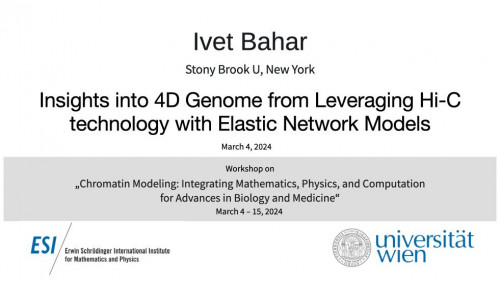
March 4, 2024 15:10 — 15:45
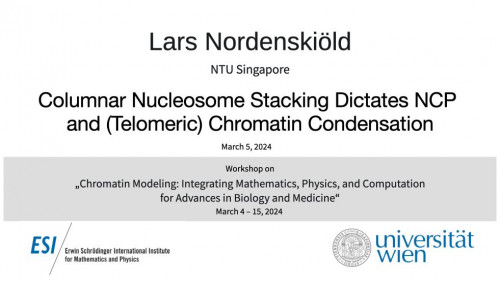
March 5, 2024 10:35 — 11:10
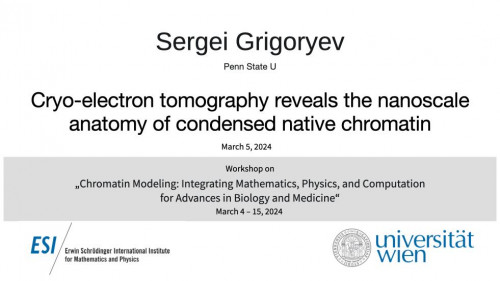
March 5, 2024 12:05 — 12:40
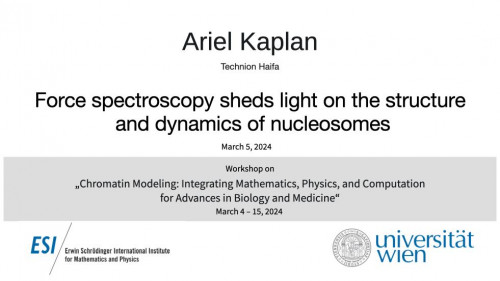
March 5, 2024 14:00 — 14:35
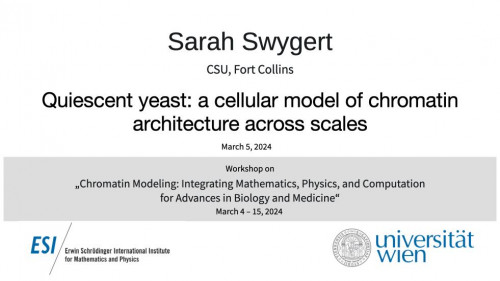
March 5, 2024 14:35 — 15:10
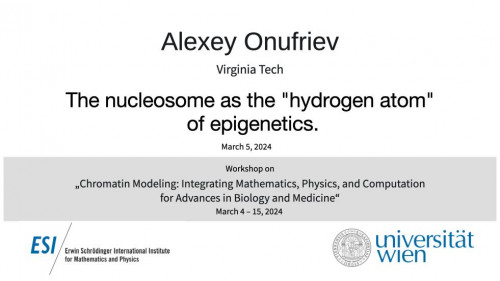
March 5, 2024 16:05 — 16:40
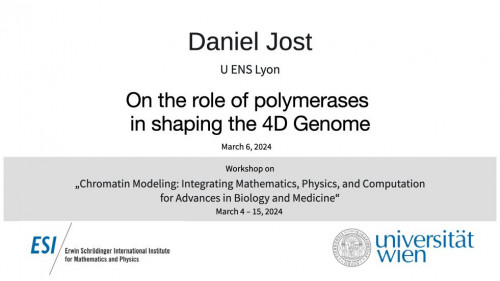
March 6, 2024 13:35 — 14:10
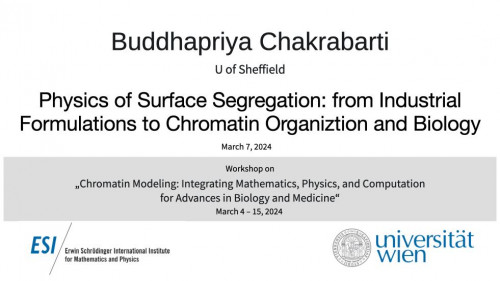
March 7, 2024 10:00 — 10:35
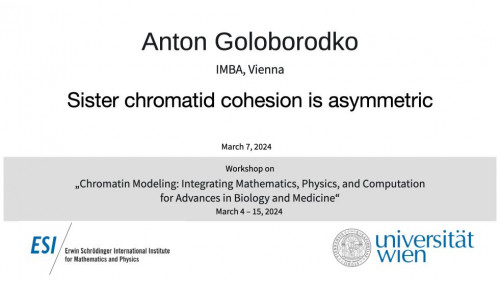
March 7, 2024 12:05 — 12:40
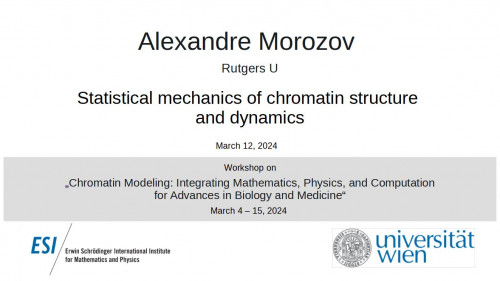
March 12, 2024 10:30 — 11:05
- Type:
- Workshop
- When:
- March 4, 2024 — March 15, 2024
- Where:
- ESI Boltzmann Lecture Hall
- Organizer(s):
-
Anton Goloborodko (IMBA, Vienna)
Tamar Schlick (NYU, New York)
Jan Smrek (U of Vienna)